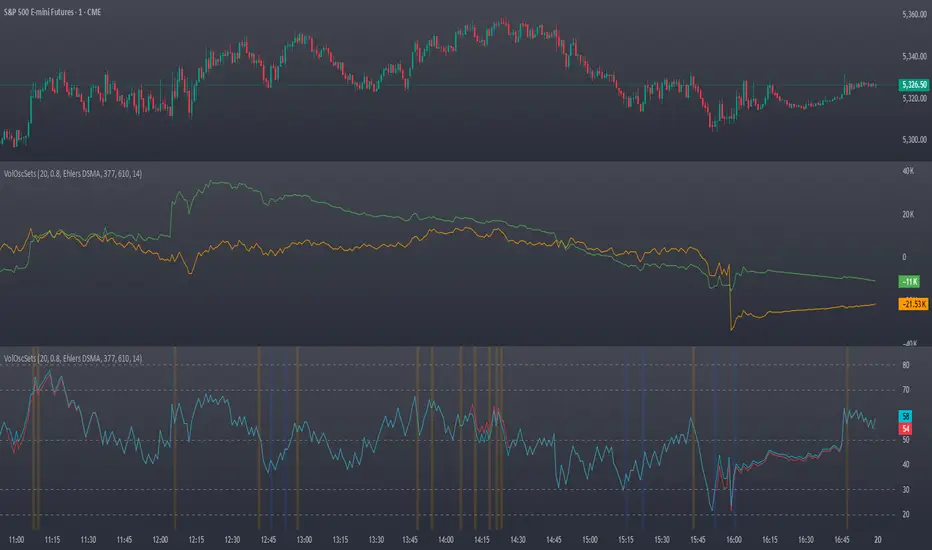OPEN-SOURCE SCRIPT
Updated OBV & AD Oscillators with Dual Smoothing Options

On Balance Volume and Accumulation/Distribution
Overlaid into 1 and then some,
Now it is an oscillator!
3 customizable moving average types
- Ehlers Deviation Scaled Moving Average
- Volatility Dynamic Moving Average
- Simple Moving Average
Each with customizable periods
And with the ability to overlay a second set too
Default Settings have a longer period MA of 377 using Ehlers DSMA to better capture the standard view of OBV and A/D.
An extra overlay of a shorter period using a Volatility DMA uses Average True Range with its own custom settings, seeks to act more as an RSI
Overlaid into 1 and then some,
Now it is an oscillator!
3 customizable moving average types
- Ehlers Deviation Scaled Moving Average
- Volatility Dynamic Moving Average
- Simple Moving Average
Each with customizable periods
And with the ability to overlay a second set too
Default Settings have a longer period MA of 377 using Ehlers DSMA to better capture the standard view of OBV and A/D.
An extra overlay of a shorter period using a Volatility DMA uses Average True Range with its own custom settings, seeks to act more as an RSI
Release Notes
added VPT and respective normalization scalingRelease Notes
Turned Volume Price Trend, On Balance Volume, Accumulation/Distribution into an RSI, different from the original which is just smoothing via moving averages.Release Notes
Added Money Flow Index MFIRelease Notes
fixed threshold reference labelsRelease Notes
added Cumulative Delta Volume (CDV) and CDV & OBV Jerk, second derivative of each respective CDV & OBV shown as background colouringRelease Notes
Jerk x RSI confluence for additional signalsRelease Notes
default views and aesthetics fixedRelease Notes
VolOscSets compresses the essential cues of a tick‑based order‑flow screen into a single TradingView study, delivering three layered signals that progress from slow intent to instantaneous aggression.Slow‑flow backbone
Long‑period Accumulation/Distribution and Volume‑Price Trend are detrended with a 377‑period Ehlers DSMA; only the distance from those means is displayed.
The slope of these curves is read as underlying sponsorship: twin rises imply persistent bid absorption, twin descents reveal sustained offer pressure.
Absolute levels are disregarded—direction and rate of change carry the information.
Momentum half‑plane
RSI is applied to OBV and CDV.
Values below 50 designate market energy clustered on the underside (oversold field); values above 50 mark crowding on the topside (overbought field).
This binary gate prevents entries into stretched flows while retaining freedom to act anywhere within the chosen half‑plane.
Additional RSIs (AD, VPT, MFI) can be toggled on for broader consensus.
Jerk ignition
The second derivative of OBV and CDV—jerk—isolates the bar where aggressive activity abruptly escalates.
Whenever jerk exceeds an adaptive 80‑percentile threshold the background flashes:
Green / red for raw buy‑ or sell‑side acceleration,
Electric‑blue when a buy‑side spike aligns with the oversold half‑plane,
Hot‑orange when a sell‑side spike aligns with the overbought half‑plane.
These coloured pulses emulate the “sweep” seen on a true tick tape
Release Notes
Stacked Jerk flash – 4‑step filterPower‑jerk
Either OBV or CDV shows a 2nd‑derivative spike above its 80‑percentile band.
Both flows agree
OBV‑jerk and CDV‑jerk must be the same sign (both buy or both sell).
Tape is alive
Relative‑volume > 1.3 × median and ATR‑rank > 25 %.
(Skips thin or flat bars.)
Price proves it
Same bar closes 1 tick beyond the jerk‑bar high (long) or low (short).
If all four pass—plus a 5‑bar cool‑down—the background paints:
Blue → long trigger
Orange → short trigger
No blue/orange = no setup; green/red shading = raw jerk only.
Release Notes
aesthetic color changes for visibilityRelease Notes
coloring and aesthetics visualsRelease Notes
visuals aesthetics viewRelease Notes
coloring customizations offeredOpen-source script
In true TradingView spirit, the creator of this script has made it open-source, so that traders can review and verify its functionality. Kudos to the author! While you can use it for free, remember that republishing the code is subject to our House Rules.
Disclaimer
The information and publications are not meant to be, and do not constitute, financial, investment, trading, or other types of advice or recommendations supplied or endorsed by TradingView. Read more in the Terms of Use.
Open-source script
In true TradingView spirit, the creator of this script has made it open-source, so that traders can review and verify its functionality. Kudos to the author! While you can use it for free, remember that republishing the code is subject to our House Rules.
Disclaimer
The information and publications are not meant to be, and do not constitute, financial, investment, trading, or other types of advice or recommendations supplied or endorsed by TradingView. Read more in the Terms of Use.